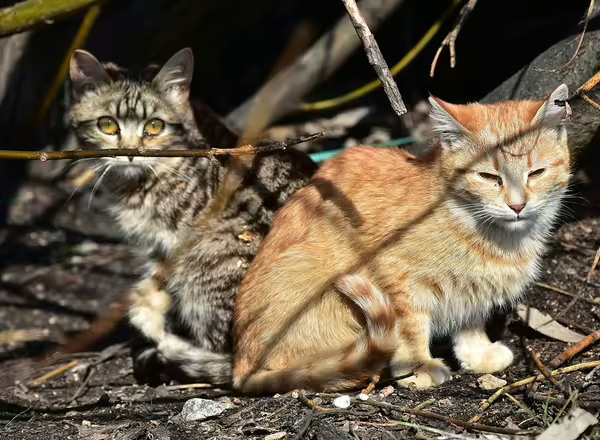Free-ranging cats (Felis catus) are domestic house cats that are either unconfined or have escaped and are feral. These cats feed on small mammals and birds, even when they are also fed by humans, and are estimated to kill 1 to 4 billion birds a year in the U.S. In rural areas, free-ranging cat populations can be large. Some cats carry parasites, pests, and rabies. Trap, neuter, release programs are legal in Illinois.
There are millions of domestic cats in the U.S., many of which are outdoors for some or all of the day. Free-ranging cats feed on small mammals and birds, even when they are also fed by humans. In the contiguous U.S., free-ranging cats are estimated to kill 1 to 4 billion birds a year, with two-thirds of the wild animal deaths being caused by unowned cats. Estimates for mammal mortality are even higher. Collectively, free-ranging cats may take 6 to 22 billion small mammals per year. Free-ranging cats kill animals that are important prey for native species, such as raptors and snakes.
In rural areas, free-ranging cat populations may be large. For example, in central Illinois, 207 to 448 cats roamed an area of 20 square miles during a 1978-80 census. Despite being fed by humans, these cats also killed mice, rats, small birds, rabbits, and native rodents.
Some cats carry the parasite Toxoplasma gondii, which causes the disease toxoplasmosis in humans and other animals, including farm animals like pigs and chickens. Contact with rabid stray or feral cats is common in parts of the U.S., which is alarming because rabies is typically fatal to humans. Cats can harbor other pests, such as fleas and viruses like distemper and feline leukemia.
Domestic cats are descended from the wild cat, Felis sylvestris, of Africa and Asia. Cats may have moved into human settlements to eat scraps and mice as early as 10,000 years ago when people began to farm the Fertile Crescent in the Mediterranean. As people moved into other regions of the world, so did tame cats that chose to avail themselves of the resources associated with human dwellings.
Many people believe that free-ranging cats are important for the control of rodent pests. In Illinois, outdoor cat densities are about three times higher on farms with livestock and livestock feed compared to homesites without livestock. In China, researchers found that women compared to men are more likely to feed free-ranging cats and that free-ranging cats have more positive interactions with women. This same study found that there are more free-ranging cats where there are more people and more cat-feeding stations.
Trap-neuter return programs promote the longevity of outdoor cat colonies, though the lifespan of an outdoor cat is typically short, four to five years in Illinois, and can be brutal due to exposure to harsh weather, disease and parasites, predators, and ill-intended people.
Many cat owners allow their cats to roam outdoors, despite the risks to their pets, to wildlife, and to humans who encounter diseased animals. The American Veterinary Medical Association encourages veterinarians to educate the public about the risks of free-ranging cats in hopes of reducing the number of outdoor cats.
Illinois requires that cats be vaccinated against rabies unless they are feral. Trap, neuter, release programs are legal in the state of Illinois.

Free-ranging cats are domestic house cats that are either unconfined or have escaped and are feral. Cats are about 2 and a half feet long, typically half of this is the tail. Coat and colors vary greatly according to breed or mix, but the size is relatively consistent.
Most free-ranging cats are associated with humans and thus are typically found around houses and other buildings. However, some successfully survive in grassy areas or forests where they can find small birds or mammals to hunt.
Free-ranging cats are smaller than native cat species and have long tails. Their footprints are nearly round, with no claw marks. Free-ranging house cats may be confused with bobcats, which are larger and have a short, bobbed tail. Tracks can be confused with those of foxes.
Trap, neuter, and release, TNR, programs are hypothesized to be an effective way to control feral cat populations. However, some research suggests that euthanasia is more effective if the implementation rate is high. A downside to TNR is the suffering and short lifespans of animals after release.
Because many free-roaming cats are owned, it is critical to conduct outreach to pet owners to inform them of the dangers cats pose to native fauna and ecosystems.
- Mammals of the eastern United States
- Nature Communications, The impact of free-ranging domestic cats on wildlife of the United States
- Demography and movements of free-ranging domestic cats in rural Illinois
- Infection, Genetics, and Evolution, Transmission dynamics of Toxoplasma gondii on a pig farm
- Scientific American, The taming of the cat
- Biological Conservation, Understanding how free-ranging cats interact with humans: a case study in China with management implications
- Journal of the American Veterinary Medical Association, The welfare of feral cats and wildlife
- American Veterinary Medical Association, Free-roaming, owned cats
- Illinois Animal Control Act (510 ILCS 5/)
- Wildlife Research, Evaluation of euthanasia and trap-neuter-return (TNR) programs in managing free-ranging cat populations